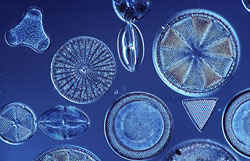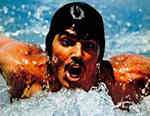
How do three sloths die all at the same time? One of my crazier ideas is maybe by falling through ice and drowning. I read a lot of forensic science literature hoping for an “Aah ha” moment when I find a technique that might give us a clue. We obviously can’t look for fluid in the sloths’ lungs, but forensic scientists have come up with an intriguing alternative–diatoms.
Drowning victims often inhale diatoms as they fight for breath. They enter the bloodstream when the alveoli in the lungs rupture and then disperse throughout the body as the heart keeps beating, winding up in well-vascularized organs and tissues, including bone marrow (Peabody, 1999). Medical examiners find them inside the femur about 1/3 of the time (Polanen, 1998). We do have an adult sloth femur, and diatoms fossilize just fine, but even if we found some inside, there’s the problem of proving they didn’t enter through small cracks as the bone sat exposed or during excavation. The femur was sealed in clay for 10,000 years but weathering and/or frost fractured it into almost 50 pieces and that’s a lot of cracks in the bone and holes in my theory. Could we sacrifice another bone that isn’t so broken. . . a rib of the toddler perhaps? Are ribs as well-vascularized as femurs? There’s another problem–it’s not that unusual to find diatoms even in the absence of drowning. Swimmers inhale them all the time. If our sloth was like Mark Spitz, he/she was loaded with them. . . . Dave 
References
Peabody, AJ. 1999. Forensic Science and Diatoms. In The Diatoms: Applications for the Environmental and Earth Sciences, EF Stoermer and JP Smol eds. Ch. 20, pp. 413-418.
Polanen, MS. 1998. Diatoms and homicide, Forensic Science International 91: 29-34.

Interesting site, I’m curious to read more about what you find. But come on–like Mark Spitz?!! Somehow I can’t see sloths competing in the 50m butterfly in this summer’s Olympics.
Thanks Travis. I may have exaggerated slightly, but never underestimate a sloth. We get our impressions of them largely from the behavior of captive 2-toed and 3-toed sloths. That doesn’t represent their natural behavior, much less that of their extinct cousins. William Beebe studied sloths in the 1920’s in their natural habitat and learned a few lessons about collecting them. #1: Don’t stand under the tree when you try to shoot one down. Apparently he had a lot of termite nests land on his head before he learned to stop shooting at brown blobs high in the trees. #2: To catch a sloth wait in the middle of the river and watch for them to swim across. Modern sloths aren’t deterred by rivers at all as they range through their territories foraging for food. They are slow but adept and graceful swimmers. Beebe simply paddled up and grabbed them by the scruff of the neck. You’re right, until competitive eating is introduced as an Olympic sport, sloths are pretty much limited to synchronized swimming.